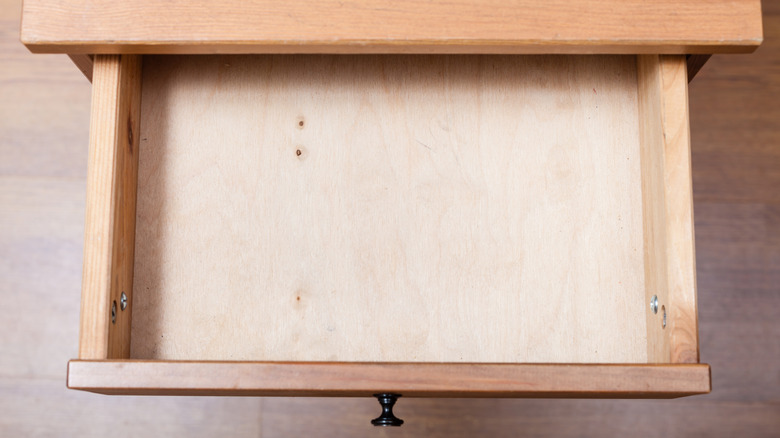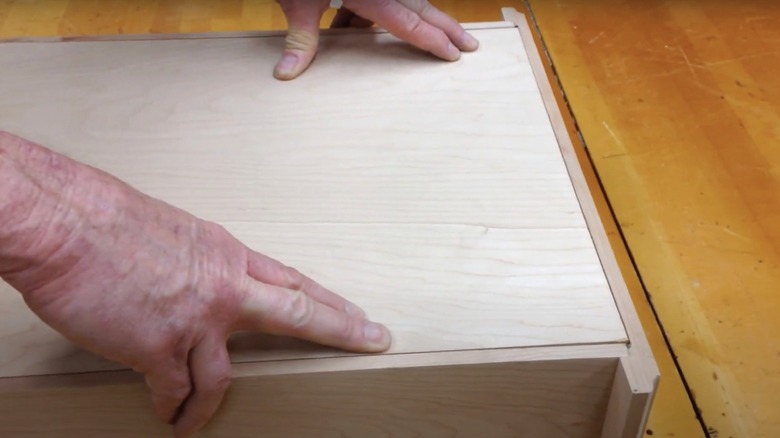The Easiest Joinery For DIY Drawers (It's Not Dovetail)
We may receive a commission on purchases made from links.
Whether you're an expert carpenter or a novice, if you love to do woodworking projects, it doesn't take long before it's time to try your hand at building a drawer. Drawers are ideal for cabinets and dressers because they add functionality, organization, and easy access while efficiently utilizing space. But constructing them can be a serious challenge, especially because unless you love battling a stuck drawer open, you'll need to make precise measurements, cuts, and smart joinery choices to ensure both structural integrity and proper alignment. You're probably familiar with dovetail joints, which feature attractive interlocking wedges. But when it comes to the easiest joinery for DIY drawers, according to House Digest's expert carpenter and remodeler, Bob Beacham, rabbet joints are simpler and more efficient to make.
"Rabbets are the easiest and fastest joints for drawers," Beacham told House Digest during an exclusive interview. "You can cut them on a table saw or with a router." The carpentry expert said that for joinery that looks a little more decorative but can also be achieved with a table saw or router, you should consider finger joints (also called box joints). "They aren't as quick as rabbets but are easier than dovetails," he explained. If your woodworking projects for beginners require speed and simplicity, rabbets are the ideal joinery choice. According to Beacham, "The only thing quicker is a butt joint (literally two pieces butted together), but these don't have the strength of a rabbet, which has a larger glue area."
How to create the perfect rabbet joint
During an exclusive interview with House Digest, Bob Beacham explained that you should dry-fit the pieces of the drawer before gluing them together. "Don't skimp on glue quality. My favorite is Titebond III, but Elmer's Wood Glue Max is also very good." Once you've assembled them, Beacham recommends using brad nails through the front, back, and corners. Then he suggests clamping your drawer from front to back and removing excess glue before leaving it to dry for 24 hours. "If you're adding a false front, the tiny nail holes won't matter. If not, knock them just below the surface, fill with a dab of wood filler, and sand smooth."
Whether you put the rabbet joints in the front, back, or sides is a matter of personal preference. "I prefer to put the rabbet in the front and back so that the end grain of the sides is hidden, and the front (in particular) looks smooth," Beacham said, adding that a false front will cover the joints, making it irrelevant where you put them. If you're in a hurry, Beacham suggested cutting "a small rabbet all the way around the drawer to insert the bottom. The alternative is to cut a groove a little way up from the bottom." But, he cautioned, you'll have to fit the bottom into your drawer at the same time as you glue it together, which can be a tricky process.
Rabbet joints are perfectly strong despite being less popular than dovetail
Since rabbets and finger joints are the easiest joinery for drawers, why is dovetailing more popular? During his exclusive interview with House Digest, Bob Beacham attributed their staying power to their overall structural strength. "Dovetail joints are popular for drawers because the interlocking design won't pull apart," he explained. Dating back to ancient Egyptian coffins, dovetail joinery exploded in popularity when it became the norm for furniture during the 1600s. "Any antique furniture with drawers will almost invariably have dovetails," the carpentry expert explained. They are one way to determine whether your antique furniture is authentic. And in Beacham's opinion, they are a great-looking option.
But despite their beauty and strength, there are some drawbacks to dovetail joints. "Dovetails are time-consuming to cut by hand and require a lot of patience," Beacham said. You'll also need to splash out on high-quality wood. "Dovetails are best for hardwoods," Beacham added. "Plywood, especially if it's cheap, can have voids, and the pins and tails (the two parts of a dovetail) can easily break."
There are fewer downsides to rabbet joints. "There really aren't any disadvantages. You could argue that rabbets are not as strong as finger joints or dovetails, but using modern glues, you'd need a pry bar to get a well-cut rabbet joint apart," Beacham said. To determine which joinery is best, consider how the drawer will be used. "If you're making kitchen or bedroom cabinets, rabbets are perfectly adequate," the expert explained. But "if you're making a jewelry box and want to show off your skills, hand-cut dovetails are the way to go."

